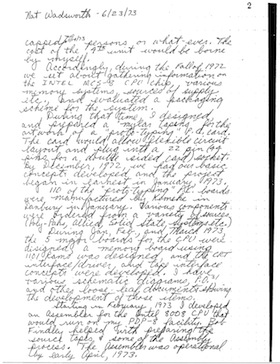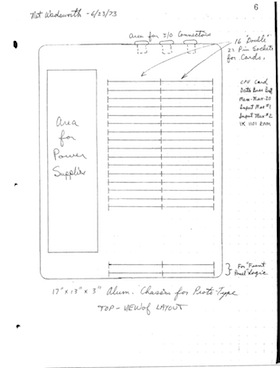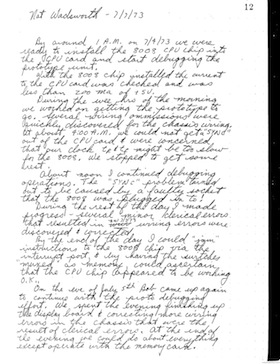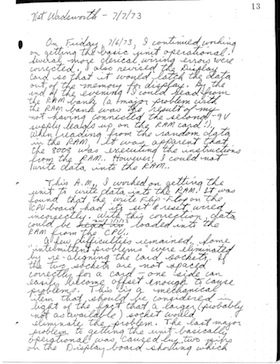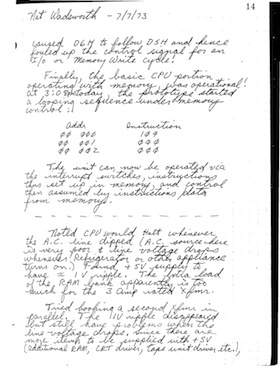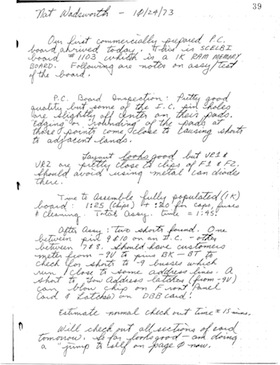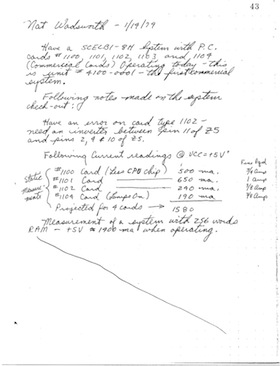6/23/73
In September of 1972 I proposed to Bob Findley & Fred Lucas, at Cook's Restaurant, in Dorien, Conn., that we pool our resources and design and each member of the group build, a mini-computer. I was interested in constructing an inexpensive mini-computer system that would have applications for handi-capped persons and other persons who could not afford expensive digital computing machines.
I proposed a system based on the INTEL MCS-8 CPU chip with a peripheral system based on an inexpensive CRT display using an ordinary oscilloscope, an inexpensive keyboard for data entry, and an inexpensive mass memory system build around an ordinary cassette audio tape recorder.
We all expressed strong agreement that such a project would be worthwhile and agreed to work together to develop the system with a goal of doing the project during the year 1973. It was agreed to pool our resources to construct a "proto-type" system first in order to have a system in operation by mid-1973 and that all members of the group would continue to assist one-another until each of us had out own system in operation. The prototype system would be used by all during the development process but would belong to either Fred or Bob. I would be building an additional system to have one available for demonstrating a mini-computers to handi-capped persons on what-ever. The cost of the 4th unit would be borne by myself.
Accordingly, during the Fall of 1972 we set about gathering information on the INTEL MCS-8 CPU chip, various memory systems, sources of supply etc., and evaluated a packaging scheme for the system.
During that time I designed and prepared a "mylar taping" for the artwork of a "proto-typing" P.C. card. The card would allow flexible circuit layout and plug into a 22 pin (44 pins for a double sided card) socket. By December, 1972, we had our basic concept developed and the project began in earnest in January, 1973.
110 of the "proto-typing" P.C. boards were manufactured by Kemake in Danbury in January. Various componentswere ordered from a variety of sources (Poly-Paks, Allied, Solid State Systems, etc.)
During Jan, Deb. and March 1973, the 5 major boards for the CPU were designed, a memory board using 1101 Rams was designed, and the CRT interface/driver, and the tape interface concepts were developed. I have various schematic diagrams, P.O. and the other loose leaf documents showing the development of these items.
Starting in February, 1973 I developed an assembler for the Intel 8008 CPU that would be run on my PDP-8 facility. Bob Findley helped with the preparing the source tapes & some of the assembly process. The assembler was operation by early April, 1973.
7/7/73
On the evening of July 3rd, Bob F. came up to my place to assist in getting the #1 prototype oeprational. We spent until midnight finishing the basic wiring for the chassis between the 5 basic cards, 1K of RAM, and a Front Panel Display board.
The front panel display board is sketched below. It holds LEDs, latches, buffers, etc. for the panel lamps, and also some circuitry for the control switches mounted on the chassis (CYCLE and RUN switches).
By around 1 A.M. on 7/4/73 we were ready to install the 8008 CPU chip into the CPU card and start debugging the prototype unit.
With the 8008 chip installed the current to the CPU card was checked and was less than 200 ma of +5V.
During the wee hrs of the morning we worked on getting the prototype to go. Several wiring omissions were quickly discovered for the chassis wiring, at about 4:00 A.M. we could not get a "SYNC" out of the CPU card & were concerned that our clock tr &l; tf might be too slow for the 8008. We stopped to get some rest.
About noon I continued debugging operations. The "SYNC" problem turned out to be caused by a faulty socket that the 8008 was plugged in to!
During the rest of the day I made progress - several minor clerical errors that resulted in wiring errors were discovered & corrected.
By the end of the day I could "jam" instructions to the 8008 CPU via the interrupt port, & by having the switches "muxed" as memory, could ascertain that the CPU chip appeared to be working O.K..
On the eve of July 5th Bob came up again to continue with the proto debugging effort. We spent the evening finishing up the display board & correcting mroe wiring errors in the chassis that were the result of clerical errors. At the end of the evening we could do about everything except operate with the memory card.
On Friday, 7/6/73 I continued working on getting the basic unit operational. Several more clerical wiring errors were corrected. I also revised the Display Card so that it would latch the data out of the memory for display. By the end fo the evening I could read from the RAM bank (a major problem with the RAM bank was the result of my not having connected the second -9V supply leads up on the RAM card!). When reading from the random data in the RAM, it was apparent that the 8008 was executing the instructions from the RAM. However, I could not write data into the RAM.
This A.M. I worked on getting the unit to write data into the RAM. It was found that the write Flip-Flop on the CPU board had its set & reset wired incorrectly. With this correction, data could be loaded into the RAM from the CPU.
A few difficulties remained. Some "intermittent problems" were eliminated by re-aligning the card sockets. If the two sockets are not spaced correctly for a card-one side can easily become offset enough to cause problems. This is a mechanical item that should not be considered in light of the fact taht a larger (probably not as available) socket would eliminate the problem. The last major problem to getting the unit basically operational casued by two pins on the Display Board shorting which caused D6H to follow D5H and hence fouled up the control signal for an I/O or memory write cycle!
Finally, the basic CPU portion operating with memory, was operational! at 3:00 P.M. today, the prototype started a looping sequence under memory control.
The unit can now be operated via the interrupt switches, instructions thus set up in memory, and control the assumed by instructions / data from memory.
Noted CPU would halt whenever the A.C. line dipped (A.C. source here is very poor & line voltage drops whenever Refrigerator or other appliance turns on.) Found +5V supply to have = 1V ripple. The extra load of the RAM bank apparently is too much for the 3 amp rated xfmr.
Tried hooking up a second xfmr in parallel. The 1V ripple disappeared buy still have problems when the line voltage drops. Since there are more items supplied with +5V (additional RAM, CRT driver, tape unit driver etc.)
10/24/73
Our first commercially prepared P.C. board arrived today. This is SCELBI board #1103 which is a 1K RAM Memory Board. Following are notes on assy / test of the board.
P.C. Board inspection : pretty good quality but some of the I.C. pin holes are slightly off center on their pads. "Edging" or "rounding" of the pads at those points come close to causing shorts to adjacent lands.
Layout
Time to assemble fully populated (1K) board: 1:25 (chips) + :20 for caps, fuses & cleaning. Total assy. time = 1:45
After assy: two shorts found. One between pin 9 & 10 on an I.C. - others between 7 & 8. Should have customers meter from -9V to pins BK - BT to check for short to -9 busses which run close to some address lines. A short to low address latches (from -9V) can blow chip on Front Panel Card & latches on DBB card!
Estimate normal check out time = 15 mins.
Will check out all sections of card tomorrow. So far looks good - am doing a "jump to self"" on page 0 now.
1/14/74
Have a SCELBI-8H system with P.C. cards #1100, 1101, 1102, 1103, and 1104 (Commercial Cards) operating today - this unit #4100-0001 - the first commercial system.
Following notes made on the system check-out:
Have an error on card type 1102 - need and inverter between pins 11 of Z5 and pins 2, 4 & 10 of Z5.
Following current readings @ Vcc = +5V
- #1100 card (less CPU chip) 500 ma
- #1101 card 650 ma
- #1102 card 24 0ma
- #1104 card (lamps on) 190 ma
- Projected for 4 cards 1580ma
2/19/74
Several complete Scelbi-8H Mini-computers made up of commercial P.C. boards - our series 1100-1104 have been assembled & operated extensively. Everything going O.K..
Our CRT display interface for oscilloscopes is in the process of being produced with commercial P.C. boards
Advertisements for the SCELBI-8H Mini-Computer have been placed inQST Magazine starting with the March, 1974 issue.
Cards for 10 mini-computers are now being assembled and checked out.
During the past 6 weeks I have designed and a prototype version assembled for an interface that tests TTL integrated circuits under control of programs in our 8H computers. During the past several weeks numerous programs for driving the interface to test various TTL devices have been developed and checked out. The results of extreme testing of TTL devices are shown on the next page.

